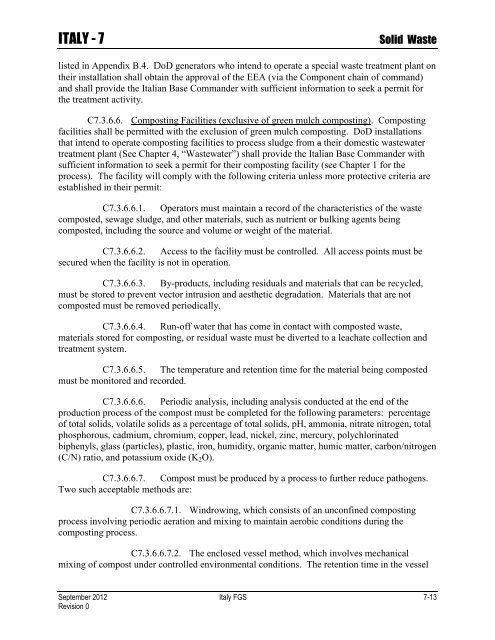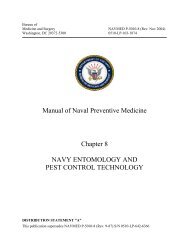ENVIRONMENTAL FINAL GOVERNING STANDARDS ITALY
ENVIRONMENTAL FINAL GOVERNING STANDARDS ITALY
ENVIRONMENTAL FINAL GOVERNING STANDARDS ITALY
You also want an ePaper? Increase the reach of your titles
YUMPU automatically turns print PDFs into web optimized ePapers that Google loves.
<strong>ITALY</strong> - 7 Solid Waste<br />
listed in Appendix B.4. DoD generators who intend to operate a special waste treatment plant on<br />
their installation shall obtain the approval of the EEA (via the Component chain of command)<br />
and shall provide the Italian Base Commander with sufficient information to seek a permit for<br />
the treatment activity.<br />
C7.3.6.6. Composting Facilities (exclusive of green mulch composting). Composting<br />
facilities shall be permitted with the exclusion of green mulch composting. DoD installations<br />
that intend to operate composting facilities to process sludge from a their domestic wastewater<br />
treatment plant (See Chapter 4, “Wastewater”) shall provide the Italian Base Commander with<br />
sufficient information to seek a permit for their composting facility (see Chapter 1 for the<br />
process). The facility will comply with the following criteria unless more protective criteria are<br />
established in their permit:<br />
C7.3.6.6.1. Operators must maintain a record of the characteristics of the waste<br />
composted, sewage sludge, and other materials, such as nutrient or bulking agents being<br />
composted, including the source and volume or weight of the material.<br />
C7.3.6.6.2. Access to the facility must be controlled. All access points must be<br />
secured when the facility is not in operation.<br />
C7.3.6.6.3. By-products, including residuals and materials that can be recycled,<br />
must be stored to prevent vector intrusion and aesthetic degradation. Materials that are not<br />
composted must be removed periodically.<br />
C7.3.6.6.4. Run-off water that has come in contact with composted waste,<br />
materials stored for composting, or residual waste must be diverted to a leachate collection and<br />
treatment system.<br />
C7.3.6.6.5. The temperature and retention time for the material being composted<br />
must be monitored and recorded.<br />
C7.3.6.6.6. Periodic analysis, including analysis conducted at the end of the<br />
production process of the compost must be completed for the following parameters: percentage<br />
of total solids, volatile solids as a percentage of total solids, pH, ammonia, nitrate nitrogen, total<br />
phosphorous, cadmium, chromium, copper, lead, nickel, zinc, mercury, polychlorinated<br />
biphenyls, glass (particles), plastic, iron, humidity, organic matter, humic matter, carbon/nitrogen<br />
(C/N) ratio, and potassium oxide (K2O).<br />
C7.3.6.6.7. Compost must be produced by a process to further reduce pathogens.<br />
Two such acceptable methods are:<br />
C7.3.6.6.7.1. Windrowing, which consists of an unconfined composting<br />
process involving periodic aeration and mixing to maintain aerobic conditions during the<br />
composting process.<br />
C7.3.6.6.7.2. The enclosed vessel method, which involves mechanical<br />
mixing of compost under controlled environmental conditions. The retention time in the vessel<br />
September 2012 Italy FGS 7-13<br />
Revision 0
















